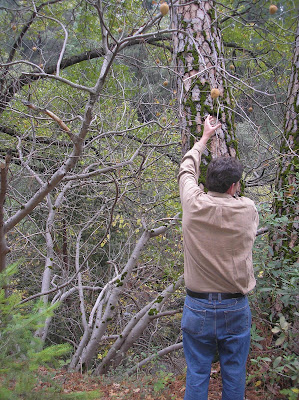
This week our challenge was to find an elm, hickory, or chestnut tree. In doing research, both in the Handbook of Nature Study and in our field guide, we discovered that a tree that we have an abundance of in our area is actually know as the California buckeye or the California horse chestnut. (Aesculus californica) This tree is more like a tall shrub that grows to between 4 and 12 feet tall.
"The Ohio buckeye is our most common native relative of the horse chestnut. Its leaves have five leaflets instead of seven. The sweet buckeye is also an American species and grows in the Allegheny Mountains."So we were off to find a buckeye tree to observe this week for our nature study.
Handbook of Nature Study, page 649

My trusty assistant helps gather a fruit to observe and then leave on the ground.
This time of year the buckeye has no leaves so we had to look for the trunk and the fruit of the tree to identify it. In the spring this tree is covered in blossoms and fill the woods with clouds of whiteness. In the summer the trees turn brown and are not quite as lovely.

There is one big difference between a buckeye and a horse chestnut, the seed is highly poisonous so don't eat it!
Here's what it says on eNature.com:
"California Indians made flour from the poisonous seeds after leaching out the toxic element with boiling water. The ground, untreated seeds were thrown into pools of water to stupefy fish, which then rose to the surface and were easily caught. Chipmunks and squirrels consume the seeds, but bees are poisoned by the nectar and pollen."
I really enjoyed this challenge because our whole family learned something about a tree we see in our own neighborhood but we didn't know much about before this study. I am going to sure to read up on the elm and the hickory to see if I can find some local connections as well.
Barb-Harmony Art Mom
